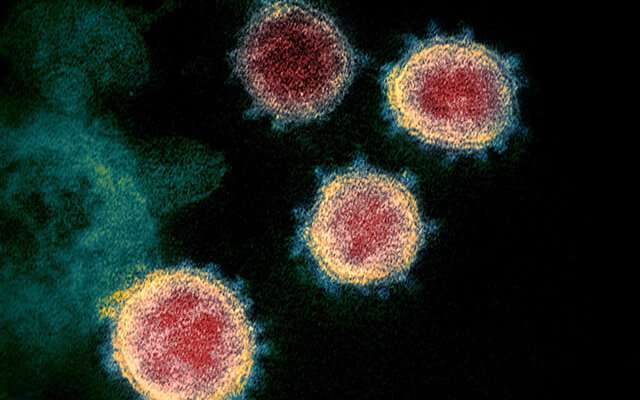
Initial findings reported by the Arizona COVID-19 Genomics Union (ACGU) suggest that following Arizona’s first reported case of COVID-19 in late January, the state experienced no cases that went undetected and was COVID-free until at least 11 distinct incursions occurred between mid-February and early April.
The published results appear in the scientific journal mBio.
Faculty at the Translational Genomics Research Institute (TGen), an affiliate of City of Hope, Northern Arizona University (NAU), University of Arizona (UArizona) and Arizona State University (ASU) launched the ACGU in April with the express purpose of tracking the causative agent of COVID-19, SARS-CoV-2: how it evolves and how it spreads into, within and out of Arizona.
The ACGU sequenced the SARS-CoV-2 genomes in as many virus-positive patient samples in Arizona as possible, and working with Arizona’s public health officials, applied the results toward statewide efforts to test and track patients, as well as provide guidance for Arizona public policy makers.
Quick action by ASU and Maricopa County public health officials, ACGU scientists agree, likely kept the first identified COVID-19 patient in Arizona—a student who had just returned from Hubei, the Chinese province where the disease originated—from igniting an outbreak, and prevented Arizona from becoming an early epicenter for the contagion.
“This is a great example of how a rapid and thorough public health response can be successful in preventing the spread of this disease,” said ACGU Director Dr. Paul Keim, Regents’ Professor of Biological Sciences and Cowden Endowed Chair in Microbiology at NAU and Executive Director of NAU’s Pathogen and Microbiome Institute.
“Similar steps could be taken when shaping future efforts to reopen businesses and schools, even though the virus continues to circulate and people remain susceptible,” added Keim, who is also a Distinguished Professor and Co-Director of TGen’s Pathogen and Microbiome Division.
Dr. Michael Worobey, an ACGU co-founder and the head of University of Arizona’s Department of Ecology and Evolutionary Biology, agrees.
“It’s a combination of the patient doing the right things to isolate himself and be aware that he possibly had this disease, and public health officials doing all the right things. Stopping an incursion of COVID-19 was a victory for the state of Arizona,” Dr. Worobey said.
This bought Arizona valuable time for preparedness efforts. The first reported case of “community” transmission occurred in Arizona in early March descended from the Washington state outbreak that was discovered in February. More than 80% of the SARS-CoV-2 genome sequences from Arizona COVID-19 cases descended from at least 11 separate lineages that were initially circulating widely in Europe, and by travel have since dominated the outbreak throughout the U.S. None of the observed transmission clusters are epidemiologically linked to the original travel-related case in the Arizona, suggesting successful early isolation and quarantine.
The ACGU uses state-of-the-art sequencers, custom computational analysis workflows, and supercomputers to determine the sequence of the virus’s RNA genome, which is just under 30,000 bases long. In contrast, there are nearly 3 billion bases in the human genome, which determine traits as simple as eye and hair color, and as complex as an individual’s propensity for cancer and other disease.
TGen has so far sequenced SARS-CoV-2 genomes from nearly 3,000 COVID-19 positive samples for the ACGU, and additional sequencing was performed at ASU and UArizona, from among the more than 200,000 positive cases in Arizona, making it one of the most robust such efforts in the nation. ACGU receives Arizona samples collected by state, county, tribal and private healthcare systems.
ACGU scientists take advantage of small changes or mutations in the virus’ genome, which naturally occur over time as the virus reproduces, to track the spread of the virus. By comparing mutations observed in Arizona to those present in strains circulating across the globe, they can determine when and from where the virus has been introduced to Arizona.
Using molecular clock analyses, researchers found that the majority of Arizona sequences are represented by two lineages—and several sub-lineages—most of which were likely introduced through domestic travel, but with some evidence for international importation.
“Through the ACGU, we are harnessing expertise in virology, genomics, evolution and bioinformatics from throughout Arizona in order to rapidly distill these genomic data into actionable insights that can complement the state’s public health response,” Dr. Keim said. “These results demonstrate the power of public health contact tracing and self-isolation following a positive test for stemming the tide of infections moving forward.”
Dr. David Engelthaler, Director of TGen North in Flagstaff, which includes the institute’s infectious disease branch, said the initial ACGU findings show how each community, each state is writing its own story for what is happing in the COVID-19 pandemic.
“We need to understand all of those plot lines that have led to where we are now,” said Dr. Engelthaler, another of the co-founders of the ACGU. “Once this disease was detected in Arizona on Jan. 26, public health immediately jumped in to make sure that all contacts were identified, samples were collected and the patient was watched very closely for the next couple of weeks to make sure there were not any more cases.”
In the coming months, he said, it will be necessary to track COVID-19 outbreaks and build epidemiological walls around each case, especially for those most at risk: persons older than 65, those in long-term care facilities, prisons, and those with pre-existing health problems.
“When you don’t have eyes on this, when you don’t have contact tracing, then it can really easily move from person-to-person,” Dr. Engelthaler said. “It’s really useful for public policy makers to be making locally-informed decisions.”
Dr. Efrem Lim, a virologist who leads the ASU team, said the SARS-CoV-2 genome sequence data can give health care providers and public policy makers an edge in fighting the pandemic.
Source: Read Full Article
